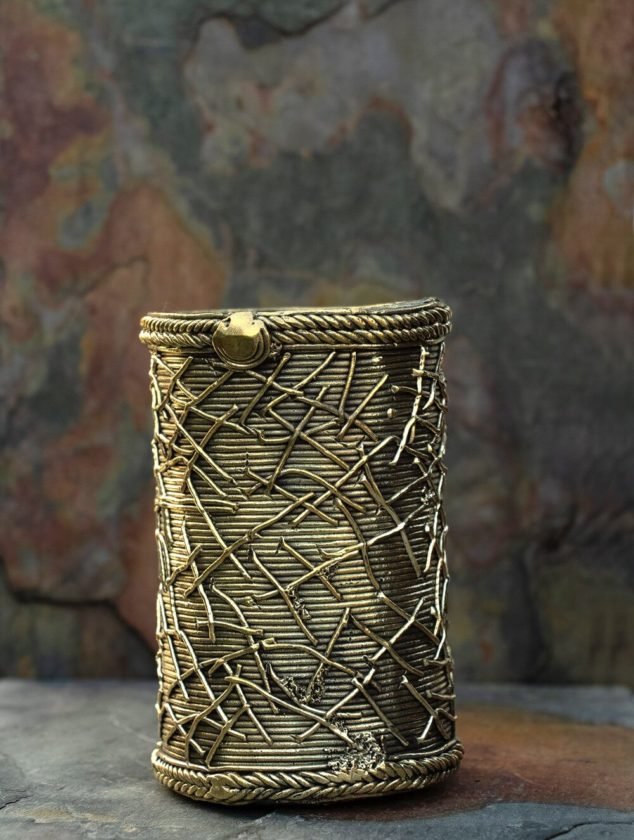Dhokra Art : A Living Reminder of Ancient Genius
Posted on May 31, 2019 by Ghoomophiro

Today we shall talk about something new …. correction, something old – something very, very old. 4000 years old. That is how old the Dhokra art is. The oldest surviving artifacts are the statue of a dancing girl found in Mahendrojaro that belonged to Indus Valley Civilisation – a statue rather famous among historians, art lovers, and archeologists alike.
Dhokra art is the beautiful artifacts, statues made by non–ferrous metal casting of copper-based alloys that use the lost-wax casting technique. The technique has also been found in China, Egypt, Nigeria, Malaysia, Central America, etc. The products continue to be in great demand among art lovers.

The name
Also spelled Dokra, Dhokra drives its names fromDhokr Damar tribes. These tribes are the traditional metalsmiths of West Bengal and Odisha. The tribe populates parts of Jharkhand, Madhya Pradesh, Chattisgarh, West Bengal and Orissa but can be found in all parts of India.
The Process
Actually, there are two main processes of lost wax casting: solid casting technique and hollow casting technique. While the first is predominant in the south of India the last is more commonly used in Central and Eastern India. Solid casting does not involve use of a clay core but instead uses a solid piece of wax to create the mold; while hollow casting is more traditional in its ways and uses the clay core.
The first task in the lost wax hollow casting process is developing a clay core which is roughly the shape of the final cast image. Next step is covering the clay core by a layer of wax created out of pure beeswax, resin from the tree Damara Orientalis, and nut oil. This wax is then shaped and carved in all its finer details of the shape of the final artifact. And thus we get a mold for the artifact we desire to create.
After that, it is covered with layers of clay, which takes the negative form of the wax on the inside. Drain ducts are left in this mold so for the wax, which melts away when the clay is cooked. As the next step, the wax is replaced by the molten metal, often using brass scrap as basic raw material. The liquid metal poured in it hardens between the core and the inner surface of the mold. The metal fills the mold and takes the same shape as the wax thus forming the artifact. All that remains is chipping off the outer layer of clay is then chipped off and the final product is there as desired.
Motifs
Dhokra is an ancient art and the motifs continue to have a primitive simplicity to them. Thus commonly occurring motifs are religious images, Dhokra horses, elephants, peacocks, owls, measuring bowls, and lamp caskets, etc.
However, the ‘primitiveness’ of these motifs do not show a lack of growth or that that they are anarchic. Rather they might hide profound wisdom. Even someone like Carl Gustav Jung, one of the biggest psychologists reads much in these archetypical symbols that keep recurring in the simple motifs of Dhokra arts.
Moreover, some of these symbols have something quite modern to them. Of particular notice is the ancient artifact of Dancing girl, who has that provoking a flirtatious smile on her face as she stands with her hand on her hip – a coquettishness marks her which does more to challenge the repressive tendencies that go by name of ‘traditions’ when it comes to gender matters.

A Declining art
Dhokra art much like several other traditional arts is seeing a very fast decline. Unlike some of the other handicrafts that are declining in India, the problem with the Dokhra art is not a lack of demand. The demand is on the higher side – both domestically and internationally.
Rather the problems are that first, the raw material is getting expensive. The artisans often poorer people are not always able to keep up with the increases in prices.
Secondly, there are problems of logistics. The producers being small are unable to bring their product to their consumers who are distant and often wide apart.
Thirdly, with increased prices and logistics costs, the final artifacts themselves get a bit too expensive and industrial products can often be cheaper.
Fourthly the industry remains untouched by any changes in technology. The artisans have failed to use any mechanization to ease their load. There is a sort of roughness to final products, a lack of final touch.
Fifthly, the newer generation is not showing much interest in art whose future seems a bit uncertain.

What can we do?
We believe Dhokra art can be much helped by some marketing. The government could use the Dhokra artifacts to decorate government buildings. A government or non-government agency might be created that will act as an intermediary between artists and their customers. Some protection needs to be given to industry. And research needs to be made in ways of improving the Dhokra technique
Conclusion
Dhokra art is an example of the ancient genius that has survived to the day despite remaining unaffected by industrialization. It shows that art finds a way of communicating itself whether or not there are technologies that support it. And we hope it shall proposer as travelers are growing more and more conscious of its importance. Cheers. J





Excellent post. I wass checking continuously this blog and I am impressed!
Very useful info particularly thhe last part 🙂 I care for such info much.
I was seekinng this certain info for a long time.
Thank you and ggood luck.
I think the admin of this site is in fact working hard in support of his website,
as here every stuff is quality based material.
I am regular reader, how are you everybody? This article posted at this website is truly good.
Generally I don’t learn article on blogs, but I wish to say that this
write-up very compelled me to take a look at and do so!
Your writing style has been surprised me. Thanks, very great
post.
Thanks for finally talking about >Dhokra Art : A Living Reminder of
Ancient Genius – Ghoomophiro <Loved it! http://uricasino114.com http://uricasino114.com